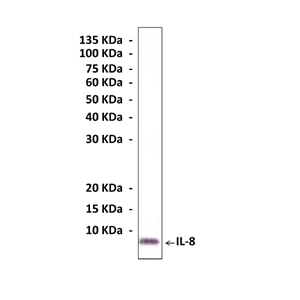Anti-IL-8: Mouse Interleukin-8 Antibody |
 |
BACKGROUND Chemokines (Chemotactic Cytokines) belong to a family of chemoattractant molecules involved in the directed migration of immune cells. Over fifty human chemokines have been identified that can be categorised into four groups; CC, CXC, CX3C and C (XCL1 and XCL2); depending on the spacing of their first two cysteine residues. Chemokines exert their effects by binding to G-protein-coupled chemokine receptors on the surface of cells, predominantly leukocytes. Eighteen human chemokine receptors have been identified that are classified according to the class of chemokines that they bind.1 The major function of chemokines is to regulate leukocyte trafficking in hematopoiesis and in innate and adaptive immunity. Other functions include angiogenic activity, apoptosis, T-cell differentiation and phagocyte activation. Inadvertent activation of chemokine receptors leads to autoimmunity by inappropriately targeting self antigens for destruction by cytotoxic T-cells and macrophages.2
Interleukin (IL)-8, an approximately 8.5 kDa protein, a member of the CXC chemokine superfamily and is produced by a wide array of cell types, including epithelial cells, neutrophils, and macrophages in response to microbial infections. In healthy tissues, IL-8 is barely detectable, but is rapidly induced by nuclear factor kappaB (NF-kappaB) and activator protein 1 (AP-1)-dependent inflammatory stimuli such as TNFalpha, bacteria or virus. Neutrophil are major specific target for IL-8 action. This allows neutrophil to eradicate the invading pathogen within the site of infection. However, many pathophysiological actions of IL-8 also depend on activation of neutrophils. IL-8 is in routine use as a marker for various clinical conditions. In addition to be a potent chemoattractant and activator for neutrophils, T-cells, basophils, and eosinophils, IL-8 was alsoshown to promote the movement of cells of different lineages, such as fibroblasts and keratinocytes. Moreover, it was shown that IL-8 induced the migration of tumor cells and its expression was correlated with tumor growth, angiogenesis and metastatic potential in various human carcinomas and animal models.3 It was suggested that constitutive expression of IL-8 in tumor cell lines is associated with the metastatic potential and that IL-8 might act as an autocrine/paracrine growth factor in colon cancer progression and metastasis. The activities of IL-8 are mediated through its binding to specific GTP-coupled, seven-helix transmembrane receptors: CXCRl and CXCR2 (also known as IL-8 receptors type A and type B, respectively).4 IL-8 also binds to a receptor on erythrocytes, DARC, which binds a number of both CXC and CC chemokines.
Interleukin (IL)-8, an approximately 8.5 kDa protein, a member of the CXC chemokine superfamily and is produced by a wide array of cell types, including epithelial cells, neutrophils, and macrophages in response to microbial infections. In healthy tissues, IL-8 is barely detectable, but is rapidly induced by nuclear factor kappaB (NF-kappaB) and activator protein 1 (AP-1)-dependent inflammatory stimuli such as TNFalpha, bacteria or virus. Neutrophil are major specific target for IL-8 action. This allows neutrophil to eradicate the invading pathogen within the site of infection. However, many pathophysiological actions of IL-8 also depend on activation of neutrophils. IL-8 is in routine use as a marker for various clinical conditions. In addition to be a potent chemoattractant and activator for neutrophils, T-cells, basophils, and eosinophils, IL-8 was alsoshown to promote the movement of cells of different lineages, such as fibroblasts and keratinocytes. Moreover, it was shown that IL-8 induced the migration of tumor cells and its expression was correlated with tumor growth, angiogenesis and metastatic potential in various human carcinomas and animal models.3 It was suggested that constitutive expression of IL-8 in tumor cell lines is associated with the metastatic potential and that IL-8 might act as an autocrine/paracrine growth factor in colon cancer progression and metastasis. The activities of IL-8 are mediated through its binding to specific GTP-coupled, seven-helix transmembrane receptors: CXCRl and CXCR2 (also known as IL-8 receptors type A and type B, respectively).4 IL-8 also binds to a receptor on erythrocytes, DARC, which binds a number of both CXC and CC chemokines.
REFERENCES
1. Zlotnik, A. & Yoshie, O.:Immunity 12:121-27, 2000
2. Locati, M.: Ann. Rev. Med. 50:425-40, 1999
3. Rubie, C. et al: World J Gastroenterol. 13:4996-5002, 2007
4. Feniger-Barish, R. et al: Biochem. 42:2874-86, 2003
2. Locati, M.: Ann. Rev. Med. 50:425-40, 1999
3. Rubie, C. et al: World J Gastroenterol. 13:4996-5002, 2007
4. Feniger-Barish, R. et al: Biochem. 42:2874-86, 2003
Products are for research use only. They are not intended for human, animal, or diagnostic applications.
Параметры
Cat.No.: | CP10326 |
Antigen: | Raised against recombinant human IL-8 fragments expressed in E. coli. |
Isotype: | Mouse IgG1 |
Species & predicted species cross- reactivity ( ): | Human, Mouse, Rat |
Applications & Suggested starting dilutions:* | WB 1:1000 IP 1:50 IHC n/d ICC n/d FACS n/d |
Predicted Molecular Weight of protein: | 8.5 kDa |
Specificity/Sensitivity: | Detects endogenous IL-8 proteins without cross-reactivity with other family members. |
Storage: | Store at -20°C, 4°C for frequent use. Avoid repeated freeze-thaw cycles. |
*Optimal working dilutions must be determined by end user.
Документы
Информация представлена исключительно в ознакомительных целях и ни при каких условиях не является публичной офертой








